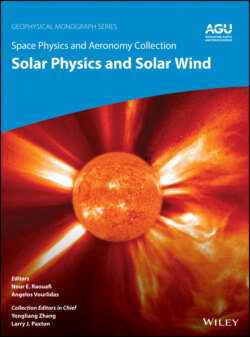Читать книгу Space Physics and Aeronomy, Solar Physics and Solar Wind - Группа авторов - Страница 20
1.3.5. Magnetic Reconnection in the Solar Wind
ОглавлениеOver the last couple of decades, magnetic reconnection has become a widely studied plasma process, ubiquitous in most if not all astrophysical contexts. Although it has long been known to occur at the Sun and in Earth’s magnetosphere, only a few studies proposed that it should be occurring frequently in the solar wind and at the interfaces of CMEs during propagation (McComas et al., 1988; Moldwin et al., 1995, 2000; Riley et al., 2004; Wei et al., 2003). Despite these suggestions, it was only later that the first in situ observational evidence for magnetic reconnection in the solar wind was provided by Gosling et al. (2005). The evidence consisted in the observation of a velocity change (or jet) bounded by two discontinuities (cf. Figure 1.13) where the flow and field properties where consistent with the Walén relation (Hudson, 1970; Phan et al., 2006) but with opposite signs. The relation is of opposite sign at each discontinuity because the Alfvénic perturbation is propagating parallel to the magnetic field at one discontinuity (A1 in Figure 1.13) but anti‐parallel at the other (A2).
Since then, a number of observational studies have shown that magnetic reconnection is indeed frequent in the solar wind. It has in particular been shown that (a) the magnetic reconnection exhausts may contain two oppositely streaming proton beams resulting from the mixing of the two populations from the inflow media (Gosling et al., 2005); (b) it often occurs at the HCS, where spacecraft typically observe counter‐streaming electron populations resulting from the mixing of either strahl or halo electrons (Gosling, 2005; Lavraud et al., 2009), signaling field lines either closed or disconnected from the Sun; (c) it occurs also well inside of 1 AU; (d) reconnection X lines in the solar wind may extend over very large distances and be active for long periods of time (from multiple spacecraft observations), suggesting that the reconnection process is not inherently intermittent (Gosling et al., 2006; Lavraud et al., 2009; Phan et al., 2006); (e) reconnection occurs for a wide range of guide fields and plasma beta properties, but is more frequent for low plasma beta (Eriksson et al., 2009; Gosling & Phan, 2013); and (f) magnetic reconnection may be driven within or at the interfaces of CMEs (Gosling et al., 2005; Ruffenach et al., 2015; Wang et al., 2012), as well as at small flux ropes in the solar wind (Feng et al., 2011; Tian et al., 2010). Many other studies, in particular based on theory and simulations, have been conducted to understand the structure of the exhaust, its boundaries, and its evolution, but these are not summarized here. It is important to note, however, that the occurrence of reconnection at CME boundaries was early perceived as broadly important (McComas et al., 1988). Indeed, its occurrence implies that the magnetic structure of the CME will change over time during propagation, so that the outer magnetic shells of the structure are peeled off, or in other words, the CME is eroded (Dasso et al., 2007; Möstl et al., 2008; Ruffenach et al., 2012; Tian et al., 2010). Direct evidence for this process was studied in detail through both case and statistical studies in Ruffenach et al. (2012, 2015), demonstrating the frequent occurrence of CME erosion during propagation. The process was also studied through global simulations by Manchester et al. (2014) and Manchester, van der Holst, and Lavraud (2014). The importance of CME erosion by magnetic reconnection also comes from its potential effect on CME geoeffectiveness (Lavraud et al., 2014).
Figure 1.13 Highly idealized planar projection of a slightly asymmetric reconnection exhaust, not to scale, convecting with the nearly radial (from the Sun) solar wind flow. The dash‐dot arrow shows an effective spacecraft trajectory through the exhaust. For simplicity, the oppositely directed exhaust is not shown.
(Source: From Gosling & Szabo, 2008. © 2008 John Wiley and Sons.)
Other broader impacts of the frequent occurrence of magnetic reconnection in the solar wind come from the fact that it may affect solar wind heating, in particular near the Sun, as well as the generation of turbulence and associated intermittency, topics that are reviewed in the next sections.
